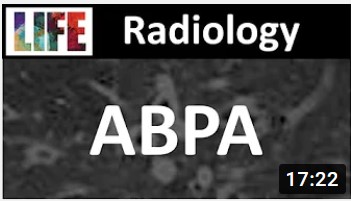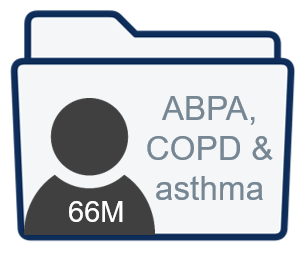Presentation
Ahmed is being treated for severe asthma by a respiratory consultant and has frequent exacerbations that require oral steroids, especially during autumn/winter. His sputum is extremely viscous and sometimes forms plugs, from which Aspergillus was recently grown.
His consultant contacted the National Aspergillosis Centre to help decide whether assessment for ABPA or SAFS would be appropriate, and whether antifungal therapy may help. She presented his case at NAC’s MDT via secure video link, where it was decided that Ahmed should be invited for an appointment at their outpatient clinic. Upon examination, you notice he is wheezing and looks slightly unkempt.

Obs & scans
| Referred from | Respiratory consultant |
| Diagnoses |
|
| Demographics |
|
| Vital signs |
|
| Lung function |
FEV1 = 48% FVC = 76% |
| Radiology | Past chest X-rays showed some infiltrates |
Radiology images by Prof Frank Gaillard (Radiopaedia)
Which tests would you order?
Microscopy, culture & sensitivity
Correct
M,C&S is essential for confirming the presence and identity of fungi present in the lungs. Azole resistance is common among many species of Aspergillus, so susceptibility testing will guide choice of antifungal
Biopsy & histopathology
Incorrect
Biopsy is an invasive procedure and would not give an informative result. This test is more relevant to nodules.
Serum BDG & galactomannan
Incorrect
Fungal antigens would not be expected in the serum. These tests are more relevant to invasive fungal infections.
Total IgE
Correct
Total IgE is often raised in atopic patients and those with allergic forms of aspergillosis. This result is used to distinguish ABPA (>1000) from similar conditions such as SAFS (<1000)
Other fungal IgE
Correct
Allergic bronchopulmonary mycosis (ABPM) is term for ABPA-like conditions cause by other fungi.
NAC measures the specific IgE of the following fungi at the initial appointment: Alternaria, Candida, Cladosporium, Penicillium, Trichophyton (as well as grass pollen, dust mites, cat/dog)
Aspergillus IgE
Correct
NOTE: most Aspergillus IgE tests are designed for Aspergillus fumigatus, but other causative species can also produce a positive result
Cystic fibrosis screening
Correct
Around 10% of cystic fibrosis (CF) patients will develop ABPA, but even unaffected carriers of CFTR mutations may be at increased risk.Thick mucus in the lungs is thought to prevent clearance of fungal spores.
NAC screens patients for CF at their initial visit. When 156 ABPA patients were genomically screened, it was found that 11.5% carried a CFTR mutation (versus 3.3% in the general UK population). Also 2 previously missed diagnoses of CF were identified (Gamaletsou et al, 2018).
Aspergillus IgG
Correct
Aspergillus IgG may be raised in allergic aspergillosis, especially if it has progressed to bronchiectasis, but this test is not part of the diagnostic criteria. At NAC this test is done at baseline, then every 6 months if the baseline result was abnormal
Aspergillus PCR
Correct
PCR is used to measure the amount of Aspergillus in the sputum
Test results
| Culture & ID | Aspergillus fumigatus |
| Sensitivity | Azole susceptible |
| Aspergillus IgG | 92 mg/L (range 0-40 mg/L) |
| Total IgE | 3273 (range 0-100 IU/ml) |
| Aspergillus IgE | 21 kUA/L (cutoff 0.35 kUA/L) |
| LFTs, FBC, U&E, ECG | Normal |
| CF screening | Normal |
- This patient shows high levels of allergic antibodies (total IgE >1000 IU/ml), with specific sensitisation to Aspergillus (positive Aspergillus IgE).
- He also tested positive for Aspergillus IgG, an antibody involved in clearing infections. While this is not one of the key diagnostics, it may be positive in ABPA patients whose condition has progressed to bronchiectasis.
- An allergic reaction to Aspergillus is contributing to this patient’s symptoms, but does that mean the patient has ABPA, SAFS or something else? Compare his symptoms and results to the infographic below to decide.
What are the different types of allergic aspergillosis?
Allergic forms of aspergillosis (ABPA, SAFS) generally occur in people with underlying conditions such as asthma or cystic fibrosis, who are unable to properly clear spores from their lungs. Ongoing exposure to this mould leads to production of pro-inflammatory cytokines and a bronchial allergic reaction, with elevated total IgE and Aspergillus IgE. Some patients with a large fungal burden may benefit from oral antifungals.
However, people without any underlying condition may also suffer respiratory symptoms if exposed to a particularly large quantity of mould spores, or for a prolonged period of time. This is typically related to damp homes or contruction work. This is not a form of aspergillosis and would not benefit from antifungal therapy.
Mould spores are a common asthma trigger, but this by itself is not aspergillosis.

ABPA
Allergic bronchopulmonary aspergillosis
Production of sticky sputum and sometimes mucus plugs, with elevated total IgE (>1000 IU/ml). If left untreated, ABPA can progress to bronchiectasis, irreversible fibrosis or CPA.
SAFS
Severe asthma with fungal sensitization
Asthma (BTS step 4 or worse) with evidence of fungal sensitisation (RAST/skin prick test), but with total IgE below 1000 IU/ml.
Aspergillus bronchitis
In rare cases, patients with mucus plugs and positive Aspergillus cultures may not show signs of being sensitised to the mould (i.e. have normal total IgE and Aspergillus IgE). Aspergillus bronchitis is a chronic superficial infection inside the bronchi, leading to expectoration of casts, inflamed aiway mucosa and sometimes mild ulcers or pseudomembrane. Find out more
Sinuses
Allergic fungal rhinosinusitis can occur in patients with or without asthma. Find out more at FungalEducation.org
Damp homes
Mould spores are a common asthma trigger, even for patients who do not meet the criteria for a diagnosis of ABPA or SAFS.
- Read NICE guidelines on indoor air quality
- Get advice from Shelter for a patient living in a damp home
Occupational exposure
Exposure to very large amounts of fungal spores can cause respiratory illness in people without asthma, especially during construction work following floods. Find out more at FungalEducation.org
What is his diagnosis?
ABPA
Correct
SAFS
Incorrect
His total IgE is >1000 IU/ml and his scans showed bronchiectasis
Aspergilloma
Incorrect
There is currently no sign of an aspergilloma on his CT scans, but occasionally ABPA can progress to chronic infections such as CPA/aspergilloma
Clinical and radiological signs are variable in ABPA, which often delays diagnosis. Different guidelines exist but NAC uses the ones published by ISHAM.
In 2013, their working group ‘ABPA in asthmatics’ held a workshop to conduct a systematic literature review and produce international consensus guidelines. These were published as Agarwal et al, 2013
A diagnosis of ABPA requires 3 criteria to be fulfilled:
An underlying condition
Bronchial asthma
or
Cystic fibrosis
Allergic sensitisation
Type I skin test for Aspergillus antigens or A. fumigatus specific IgE
and
Elevated total IgE (>1000 IU/mL)
2 of 3
Serum precipitating IgG antibodies to Aspergillus fumigatus
Radiographic pulmonary opacities consistent with ABPA
Total eosinophil count over 500 cells/µL in steroid naïve patients
Rosenberg-Patterson 1977 guidelines
An older set of diagnostic criteria was proposed by Rosenberg et al (1977) that is still used in some settings. Eight criteria = ABPA certain. Seven criteria = ABPA probable.
Criteria:
- Episodic wheezing (asthma)
- Eosinophilia (increase in the number of certain white blood cells which fight disease)
- Immediate skin test reactivity to Aspergillus antigens
- Precipitating (IgG) antibodies to Aspergillus
- Elevated total IgE
- Elevated Aspergillus-specific IgE
- Central bronchiectasis
- History of pulmonary infiltrates (seen on X-ray)
Asano 2021 guidelines
Asano et al (2021) recently expanded the guidelines to provide better sensitivity in patients who did not have asthma or cystic fibrosis, as well as those affected by species other than Aspergillus.
Treatment
As he was already taking systemic glucocorticoids with incomplete control, Ahmed was started on 200 mg BD itraconazole as per IDSA treatment guidelines (Patterson et al, 2016). Itraconazole is a CYP3A4 inhibitor, so his sertraline dosage was halved for the duration of antifungal treatment. Therapeutic drug monitoring was used to ensure his drug levels were within the target range.
After 8 months his total IgE had reduced and he was able to stop taking itraconazole. The bronchiectasis had not progressed during this time, although this will be monitored with yearly CT scans. He felt better in himself and was able to slowly reduce his prednisolone dosage, but not come off it entirely. He may be re-referred in future if the ABPA relapses. His symptoms are not severe enough to require biological therapies (e.g. omalizumab) at this stage.
After discussion with NAC’s specialist physiotherapists, he trialled nebulised saline and found it helpful for clearing his chest. He has also joined the online support group and feels less isolated now that he can talk with other ABPA patients.
Anything else?
Mental health
Under-treated depression can interfere with a patient’s ability to manage their medical treatments and self-care, as well as weakening their immune system. Conversely, a new diagnosis is often stressful and can aggravate or lead to mental health problems.
- This would be a good time for his GP to review his depression treatment plan, especially as his sertaline dose was reduced while on antifungals
- Make sure he knows how to self-refer to his local IAPT service or find a private therapist
- Direct him to Books on Prescription and NHS self-help guides
Support groups
The National Aspergillosis Centre provides plenty of patient support and information resources, which are aimed at any NHS patients
- Aspergillosis.org
- Facebook support group
- Twitter @MFT_NAC
- Contact the National Aspergillosis Centre’s CARES team for details of secure Telegram chat group and Zoom groups
Exercise
As someone with both lung conditions and depression, Ahmed is particularly likely to benefit from regular gentle exercise. However, this can be difficult to achieve for someone who often feels breathless and is socially isolated, or on a low income. It is important to make sure he is aware of local charity groups and exercise referral schemes for which he is eligible.
Phil Langridge (specialist aspergillosis physiotherapist at NAC) has recorded a free webinar aimed at patients, which explains how to set realistic fitness goals and make progress without causing an injury.
The British Lung Foundation has also produced a series of exercise videos suitable for respiratory patients.
Aspergillus IgE rapid LFT
A rapid lateral flow test for Aspergillus antibodies is available from LDBio but is not yet widely used in clinics. A study at NAC (Stucky Hunter et al, 2019) showed that it had 91.4% sensitivity and 81.7% specificity when differentiating between ABPA patients and patients with other lung conditions.









